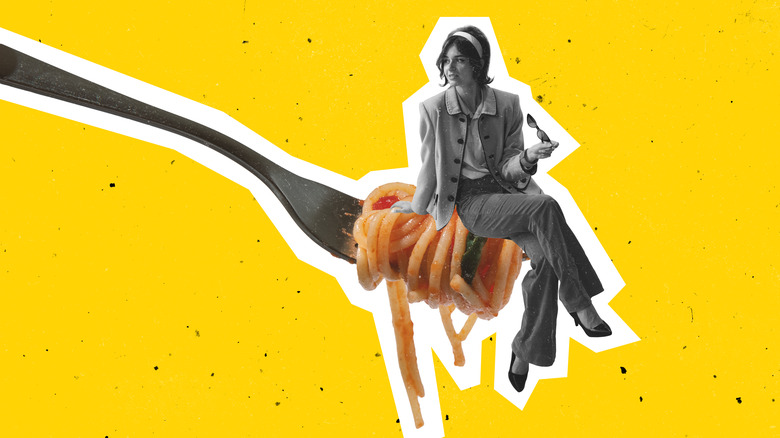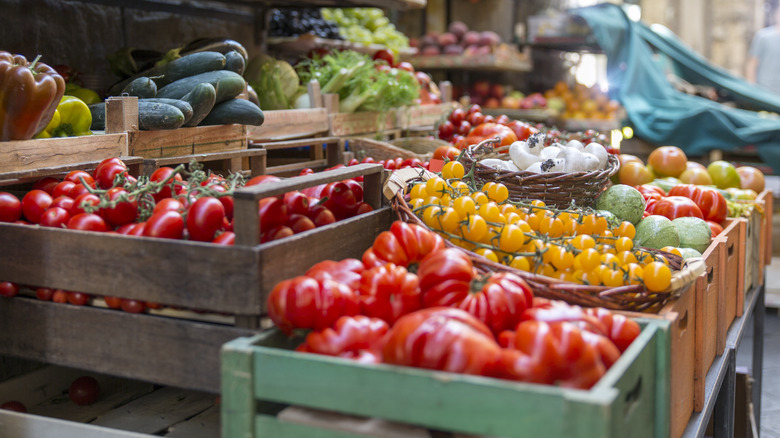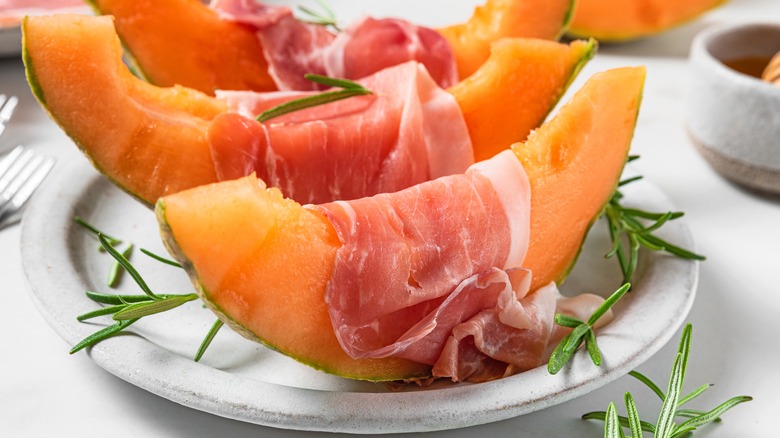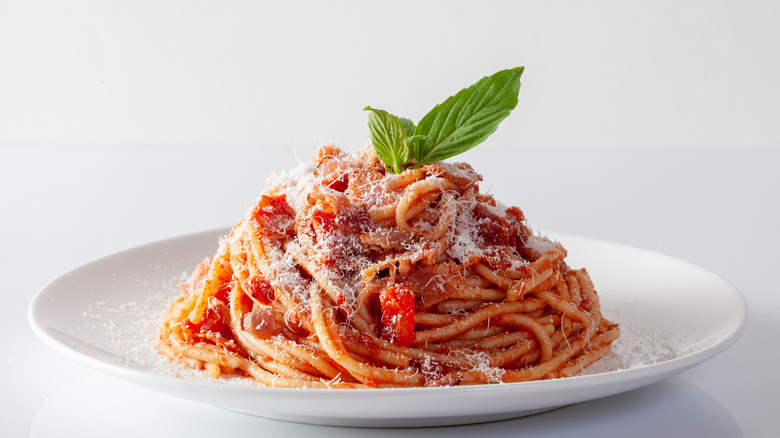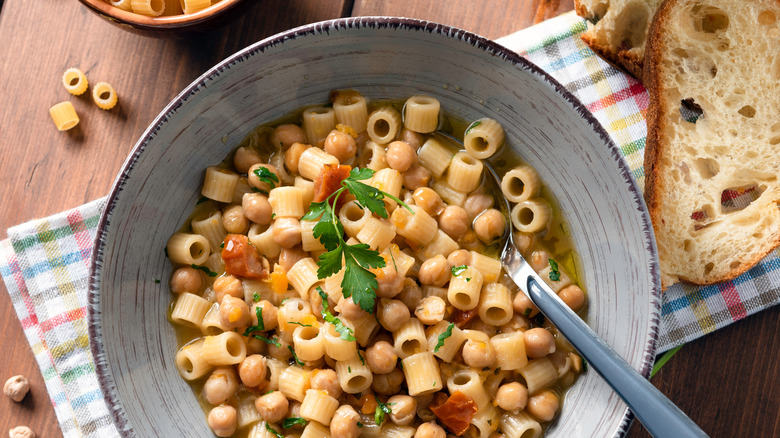You'll Never Get Italian Food Right If You Keep Overthinking It
This might sound controversial, but Italian food is basic. To be clear, this isn't a rant about how the cuisine is nothing more than pizza, pasta, and red sauce. Rather than drone on about what's become characteristic of Italian food in the U.S. following waves of mainly southern Italian immigrants in post-war periods and how that's not "authentic" Italian cuisine, our claim is entirely different. When it comes to real-deal Italian food (you know, the kind that an Italian living in Italy would cook) people tend to seriously misunderstand the ethos of the cuisine, which leads to mistakes in the kitchen.
After spending several years studying food culture and living in Italy, I've discovered that when it comes down to it, the idea of "less is more" tends to be a recurring theme, regardless of the recipe at hand. While dishes can of course be quite varied across the diverse regions of Italy, the one aspect that remains constant is the emphasis on using quality ingredients in uncomplicated ways. Once you consider the pillars of Italian cuisine — many of which relate back to a history of cucina povera, or peasant-style cookery — you'll recognize that Italian food is actually pretty simple.
Minimalist in its nature, but maximalist in flavor, your Italian food will always be lacking if you don't approach it correctly.
Work with a handful of high-quality ingredients
If you've ever tasted the perfection that is an Italian just-picked tomato, still warm from the sun, we're here to confirm that euphoria wasn't a vacation-induced placebo effect. In comparison to the U.S., Focus for Health shares that European food laws are stricter when it comes to the use of additives and pesticides and the presence of GMOs. Though this means mass-produced foodstuffs are regulated to a high degree, it also means smaller-scale production is prevalent.
The overwhelming presence of farmer's markets dedicated to low-intervention agriculture allows produce to express terroir and, more importantly, flavor. There is a huge focus on highlighting local and seasonal ingredients, whether that be vibrant radicchio in the winter, delicate zucchini flowers in the spring, juicy summertime tomatoes, or the sweet persimmons typical of autumn. Opting for "zero kilometer foods" in particular ensures quality as it guarantees that produce hasn't been picked prematurely and traveled long distances, losing flavor in the process.
But, of course, quality ingredients don't stop at fresh fruits and vegetables. Some of Italy's greatest delicacies are minimally processed goods like oil-packed tuna or sun-dried tomatoes that work to preserve and concentrate these rich, local, and often seasonal flavors. Other products such as decadent Aceto Balsamico di Modena I.G.P. or umami-focused Soppressata di Calabria D.O.P. boast especially high value. Linked to place — guaranteed by certification like protected geographical indication or protected designation of origin – they're produced according to traditional and simplistic methods, which brings us to our next point.
Focus on the details, not complicated tools and techniques
If you've been paying attention, you can likely guess Italian cuisine doesn't require a bunch of fancy tools to execute — a knife, wooden spoon, spider strainer, and some pots and pans will suffice. The key to success, however, is in the details.
Whether simmering a sauce or braising a piece of meat, many dishes start with sautéeing a three-ingredient soffritto of onions, carrots, and celery, which creates a foundation for flavor. Similarly, infusing olive oil with a bit of garlic or chili flakes works the same way, while also acting as the ultimate lesson in cooking low and slow as a means of extracting maximum flavor. Skipping either of these steps will result in a much less dynamic dish than you were served at that hole-in-the-wall Italian eatery. While your food will taste fine (hey, maybe even good), without those small details there will always be something missing that you can't quite put your finger on.
With origins dating back to ancient Rome, it's hard to talk about Italian food without mentioning pasta. Consisting of just a few ingredients (flour, water, and sometimes eggs for added richness) making fresh pasta relies on knowing how to properly work the dough, and then you have to be sure you're cooking it to a toothsome al dente. Developing a great sauce can be equally tricky — consider how few ingredients carbonara or al Pomodoro require but how easily they can fall flat. Top-of-the-line kitchen tools and the newest gadgets won't help you achieve great Italian food if you're focusing on the wrong things.
Sparingly seasoned, but for a reason
Much like the reliance on quality ingredients and perfecting elementary techniques, another aspect that echoes simplicity is the lack of heavy-handed seasoning. In fact, in Pellegrino Artusi's "The Art of Eating Well," the father of modern Italian gastronomy famously expressed that flavorings should enhance ingredients, not detract from them.
Although herbs and spices make notable appearances in Italian cuisine, a little goes a long way. When added early on in the cooking process, dried seasonings like a dash of nutmeg, sprinkle of oregano, or single bay leaf can help draw out nuanced flavors. Likewise, just-picked herbs like basil, rosemary, and parsley are used in moderation, often as a subtle garnish.
Even when spices and herbs play a key role in a recipe, they are manipulated in ways that extract the most flavor and aroma. For instance, when making cacio e pepe, freshly cracked black pepper is first toasted to heighten its intensity.
Beyond spices and herbs, luxury ingredients are often used sparingly to enhance food. Boasting bold flavors (often the result of strenuous aging processes), things like 40-month-aged Parmigiano-Reggiano, truffles, or colatura di alici from Cetera are used as a final touch meant to complement rather than overwhelm a dish; The same can be said for equally punchy, though more budget-friendly, ingredients like capers or anchovies. When it comes to Italian cooking, in most cases less is more.
The essence of cucina povera
It's no surprise that simplicity and restraint are displayed in so many modern Italian recipes, as these aspects are foundational to cucina povera, which was born from the need to turn a few basic ingredients into something both delicious and satisfying. Relying on making do with whatever was available and following a taste-as-you-go method, Italian cuisine has become known for non-recipe recipes that are simple, yet extraordinary.
While ingredients have become more mass-produced and culinary techniques more numerous than they were in the past, if you find your Italian recipes are consistently falling short, it's likely you're overthinking things. Start by investing in quality ingredients like extra virgin olive oil, a nice can of anchovies, or a wedge of Grana Padano and selecting recipes that feature local, seasonal produce, using spices and other ingredients in ways that don't attempt to mask their true essence.
Stop overthinking things and focus on what truly makes the best (and most authentic) Italian food: phenomenal ingredients given the opportunity to shine.
